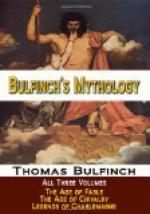Returning to Sigtryg, the young Saxon told all that he had learned, and the Danes planned an ambush in the ravine where Haco had decided to blind and set free his captives. The whole was carried out exactly as Hereward arranged it. The Cornishmen, with the Danish captives, passed first without attack; next came Haco, riding grim and ferocious beside his silent bride, he exulting in his success, she looking eagerly for any signs of rescue. As they passed Hereward sprang from his shelter, crying, “Upon them, Danes, and set your brethren free!” and himself struck down Haco and smote off his head. There was a short struggle, but soon the rescued Danes were able to aid their deliverers, and the Cornish guards were all slain; the men of King Alef, never very zealous for the cause of Haco, fled, and the Danes were left masters of the field.
Sigtryg had in the meantime seen to the safety of the princess, and now, placing her between himself and Hereward, he escorted her to the ship, which soon brought them to Waterford and a happy bridal. The Prince and Princess of Waterford always recognized in Hereward their deliverer and best friend, and in their gratitude wished him to dwell with them always; but the hero’s roving and daring temper forbade his settling down, but rather urged him on to deeds of arms in other lands, where he quickly won a renown second to none.
ROBIN HOOD
Among the earliest heirlooms of the Anglo-Saxon tongue are the songs and legends of Robin Hood and his merry outlaws, which have charmed readers young and old for more than six hundred years. These entertaining stories date back to the time when Chaucer wrote his “Canterbury Tales,” when the minstrel and scribe stood in the place of the more prim and precise modern printed book.
The question of whether or not Robin Hood was a real person has been asked for many years, just as a similar question has been asked about William Tell and others whom everyone would much rather accept on faith. It cannot be answered by a brief “yes” or “no,” even though learned men have pored over ancient records and have written books on the subject. According to the general belief Robin was an outlaw in the reign of Richard I, when in the depths of Sherwood Forest he entertained one hundred tall men, all good archers, with the spoil he took; but “he suffered no woman to be oppressed or otherwise molested; poore men’s goods he spared, abundantlie relieving them with that which by theft he got from abbeys and houses of rich carles.” Consequently Robin was an immense favorite with the common people.
This popularity extended from the leader to all the members of his hardy band. “God save Robin Hood and all his good yeomanry” is the ending of many old ballads. The clever archer who could outshoot his fellows, the brave yeoman inured to blows, and the man who could be true to his friends through thick and thin were favorites for all time; and they have been idealized in the persons of Robin Hood and his merry outlaws.




